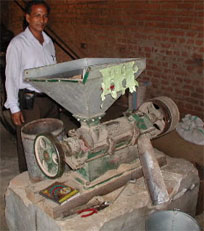|
Village-type rice mills can be found
in rural communities and are used for service milling paddy
of farmers for home consumption. In many cases, village mills
are adaptations of the Engleberg coffee huller from the
United States, modified for milling rice.
These mills, however, are notorious for
breaking paddy grain. Because of the high breakage, the total
milled rice recovery is 53-55%, and head rice recovery is on
the order of 30% of the milled rice.

A village mill
Nowadays, many Engleberg mills are replaced
by the single-pass compact rice mill. A typical compact
rice mill consists of a small rubber-roller husker and a friction
whitener. The two byproducts of the compact mill--husk and bran--are
discharged separately. The milling performance of the compact
rice mill is superior to the single pass Engleberg huller. Milling
recoveries are normally above 60%.

A compact mill
|

